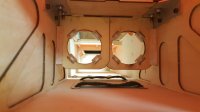stangflyer
I like 'em "BIG"!
Makes the walk of shame less painful.Nice of them to crash it right by the vehicle. [emoji102]
BJ Swope

Makes the walk of shame less painful.Nice of them to crash it right by the vehicle. [emoji102]
BJ Swope

I had a guy crash just a few feet in front of the hood of my truck a few weeks ago. The worst part was it almost hit me on the way by.Nice of them to crash it right by the vehicle. [emoji102]
BJ Swope
I thought that happens after impact? View attachment 44654
Or like the Mars Orbiter they used English calculations instead of Metric.No...that there is somebody rounded off and didn't keep enough significant digits in their calculations. Looks like they also forgot a (-) somewhere and went down instead of up. Jeeze....I hope when I do eventually dumb thumb one in it looks like that when its over with so I don't even have to worry about repairing it.
First off, do we even need all this baffling if it's not a four cylinder? 3W would send me killer built planes with so many details installed, but no baffling, and they are an engine company. I have always just ran a lower ledge piece and that's all and my engines have always run cool. Although I do run them a little rich. After the first ten gallons on a new engine, when I shoot the engines with a variety of temp guns I get an average of 135F upon landing. Second, are these motors running at 150 degrees Fahrenheit, like the temp guns say, or or they running 350 degrees Fahrenheit like the guys with telemetry sensors are saying? I can hold onto my heads right after I land... doesn't seem like 350 degrees to me.
Anyway, I mostly did this baffling job for Tony Russo because he told me baffling is a big deal. And, I like Tony because he's ornery. hehe
I went with an 1/8" gap in the front because that's what I usually do. And, I went with 3/8" in the back because that's what Dave Johnson said works well:
]
Just curious where you mount your temp sensor?I have found that baffling is a must. My last plane was a PAU Extra 300SP. DA 170 on Planebender smooth pipes. I did an experiment and did not baffle at all. I flew the plane and within 60 seconds my telemetry alarm was going off. 350F. I was at 1/4 throttle most of the time and maybe hit 1/2 throttle for short periods of time. Even on a downline the temps really did not change much. So I only made a short flight that day. I added baffles like you see a lot on these forums with just some guides to the front of the cylinder. That yielded much better result but I was still hitting 350F pretty easy. But I was able to fly lightly that day. My final design was to add baffling wrapped to the back of the cylinders. Much better now. Only on a long upline on a full pull would it touch over 300F. DA has always told me to shoot for under 300F.
FYI, landing temps can easily drop 80-100F. So an IR gun really is a waste of time and as Terry said the reflective surface causes issues. I have recorded a difference of up to 60F between a temps sensor reading and IR reading. The IR was the lower number.
I have found that baffling is a must. .... My final design was to add baffling wrapped to the back of the cylinders. Much better now.


